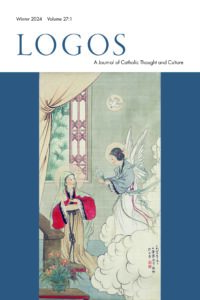
Xiaobai Chu
Logos: A Journal of Catholic Thought and Culture, Volume 27, Number 1, Winter 2024
Abstract: From the late Qing Dynasty (viz. mid–nineteenth century to 1911) to the early Republic of China (1911–1920s), the Catholic Church introduced a large number of religious paintings to display in churches and for individual believers, including the importation of icons from Europe as well as painting production from local Catholic institutions such as the Tou-se-we Painting House. Among them, only a few images were in a Chinese style. Some of these are documented in Daniel J. Fleming’s Each with His Own Brush: Contemporary Christian Art in Asia and Africa and in an article by Shen and Roberts in The Chinese Recorder. Fleming notes that “among the earliest modern Chinese Christian paintings are those in the hospital of the Church Missionary Society, Hangchow, produced a few years before 1900,” while the article informs us about two small-scale groups of artists, the St. Luke Society and the Church Art Cooperative Society, who collaborated to produce a number of “Christmas cards, such as the Adoration of the Magi and the Madonna of the Radiant Sun.” Apart from such sporadic records, it is difficult to find the traces of these Sino-Christian paintings today. Of course, this also shows that they did not reach a critical number in production, sales, and popularity at the time. This stands in stark contrast to the Christian paintings produced by Chinese Catholics at Fu Jen University in the 1930s and 1940s. Although the Fu Jen Catholic artistic practice from 1930 to 1940 was forced to end along with the Fu Jen Catholic University in Mainland China, its creative characteristics were distinctive, its output reached a certain scale, and its influence extended far beyond, to Europe and the United States. More importantly, the substantive issues the Fu Jen paintings articulate map well onto the bigger picture of the inculturation of Christianity in China.
Besides introducing the Fu Jen Catholic paintings and their creators, I will answer two questions in this paper: First, why did Fu Jen artists undertake to fight a “losing battle” in creating old-fashioned Chinese Christian paintings that were at odds with the antitraditional and anti-Christian sentiment of their era? Second, why were the reactions from Western and Chinese audiences so different—that is to say, appreciation and praise from foreign audiences, on the one hand, and indifference and even rejection from Chinese people, on the other? I will argue that first, although Fu Jen was a missionary university during the Chinese anti-Christian movement in the 1920s, the university’s educational philosophy was to teach Chinese culture and modern academic subjects on a non-religious basis. At the same time, the contemporary Chinese art scene advocated Western-style realistic painting, while rejecting traditional Chinese painting. Against this background, the Fu Jen painters were marginalized in two ways: because they were Catholics and because they were traditional painters. It was in this dual predicament that Fu Jen painters, encouraged and instructed by Western missionaries, tried to represent classic Christian themes in the form of traditional Chinese visual art in order to find a way out of their identity crisis. In the process, their “split-identities” as traditional Chinese painters and Christian believers grew together and, in their combination, gained a new strength and meaning for them. Second, while European modernism was working hard to create the primacy of spiritual vision and anti-illusionism, modern Chinese reformers precisely sought to offload this artistic burden. The difference between the responses of Western and urban Chinese audiences was fundamentally caused by this opposing stance on visual modernity. Furthermore, for Christian believers, the difference was rooted in a theological disagreement. Western viewers deeply rooted in their Christian tradition could allow themselves more tolerance for grasping the Christian spirit in the new Chinese form, while their Chinese counterparts saw the Chinese features in Christian paintings as syncretistic, combining Christianity and Chinese traditions (notably Buddhism and Confucianism).
About the author: Xiaobai Chu was a HYI Visiting Scholar from 2022-23.
